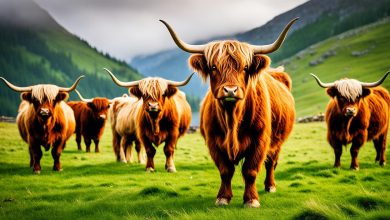The longhorn cowfish (Lactoria cornuta) stands out with its long, horn-like features on its head. It lives in the Indo-Pacific region and can grow up to 50 cm (20 in) long. This fish is known for its unique look and amazing abilities, making it a fascinating creature of tropical waters.
The longhorn cowfish is part of the Lactoria genus and the boxfish family. These fish are known for their box-like bodies. They are great at living in coral reefs and rocky places. They seem to float through the water with ease.
Introducing the Longhorn Cowfish
Appearance and Size
The longhorn cowfish stands out in the boxfish family with its unique look. It has a yellow to olive base color and white or bluish spots. Its most eye-catching feature is the pair of long, horn-like projections from its head.
Its large eyes sit right behind these horns, giving it an otherworldly look. The body is covered in fused, hexagonal scales that form a strong, box-like shell. From this shell, the fins and tail stick out, helping the fish move smoothly.
Adult longhorn cowfish can grow up to 20 inches long. But in aquariums, they usually don’t get bigger than 16 inches.
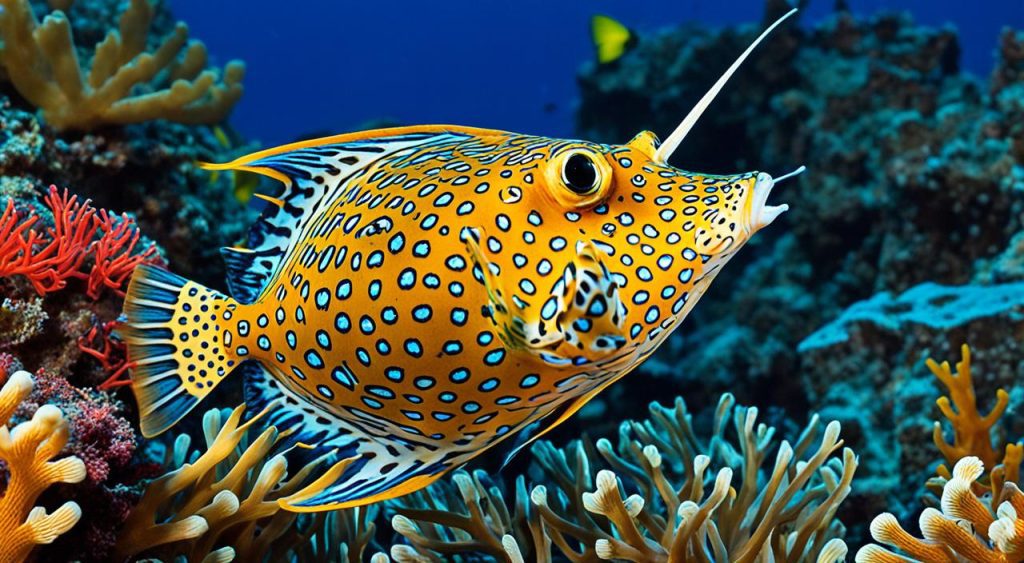
“The longhorn cowfish’s distinctive appearance, with its long, horn-like projections and fused hexagonal scales, makes it one of the most unique and captivating members of the boxfish family.”
Habitat and Distribution
The longhorn cowfish is known for its unique look. It lives in tropical and subtropical waters. You can find it in coral reef areas, like lagoons, reef flats, estuaries, bays, and protected seaward reefs.
These fish are often seen near Acropora corals, where young ones hide. This shows how important coral reefs are for their survival and growth.
The longhorn cowfish lives in many places, from the Red Sea to the Marquesas Islands. It can even be found as far north as southern Japan. In the Atlantic Ocean, it’s seen off the coast of southern Africa. This shows how well it can adapt to different marine habitats.
| Habitat Characteristics | Geographic Distribution |
|---|---|
| Coral reefs Lagoons Reef flats Estuaries and bays Protected seaward reefs Juveniles associate with Acropora corals | Red Sea and East Africa Eastward through Indonesia Marquesas Islands Southern Japan, including Ryukyu Islands Southern Africa (Atlantic Ocean) |
The longhorn cowfish lives in many places and loves coral reefs. Knowing where it lives helps us protect these important marine areas. This is key for keeping the ocean healthy.
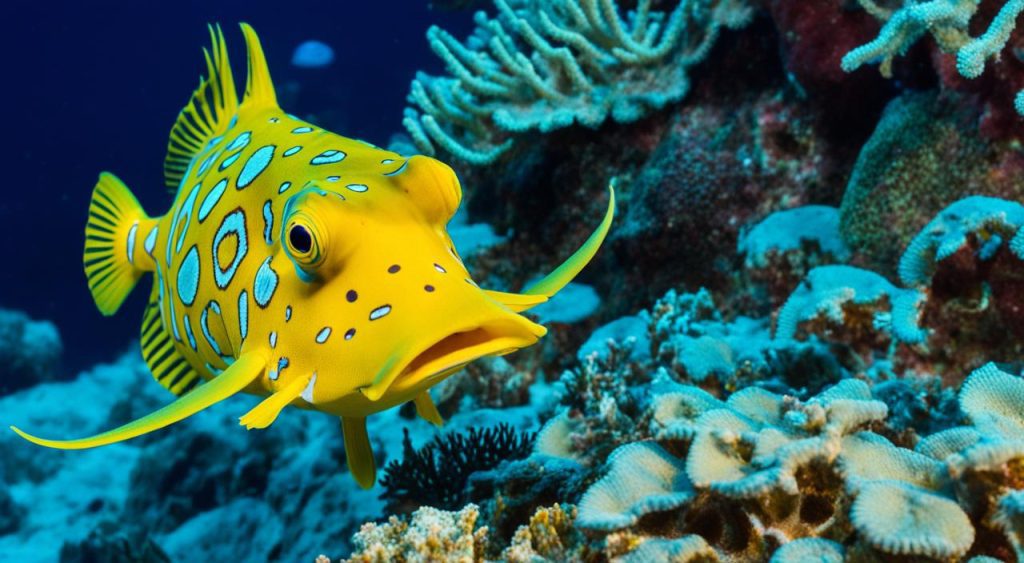
Feeding Habits and Diet
Omnivorous Foragers
The Longhorn Cowfish eats a wide variety of food. They enjoy benthic algae, microorganisms, and foraminiferans from the sand. They also eat sponges, polychaete worms, mollusks, small crustaceans, and small fish.
They have a special way of finding food. They blow water into the sand to uncover hidden prey. This lets them eat benthic invertebrates living under the sea floor.
In the wild, they love to eat small crustaceans, polychaete worms, algae, and other sea creatures. Their eating habits help keep their underwater world balanced. They control the numbers of some invertebrates and algae.
At home in aquariums, they eat frozen foods, pellets, and marine algae. Sometimes, they get to scrape algae off surfaces. This diet keeps them healthy and growing well.
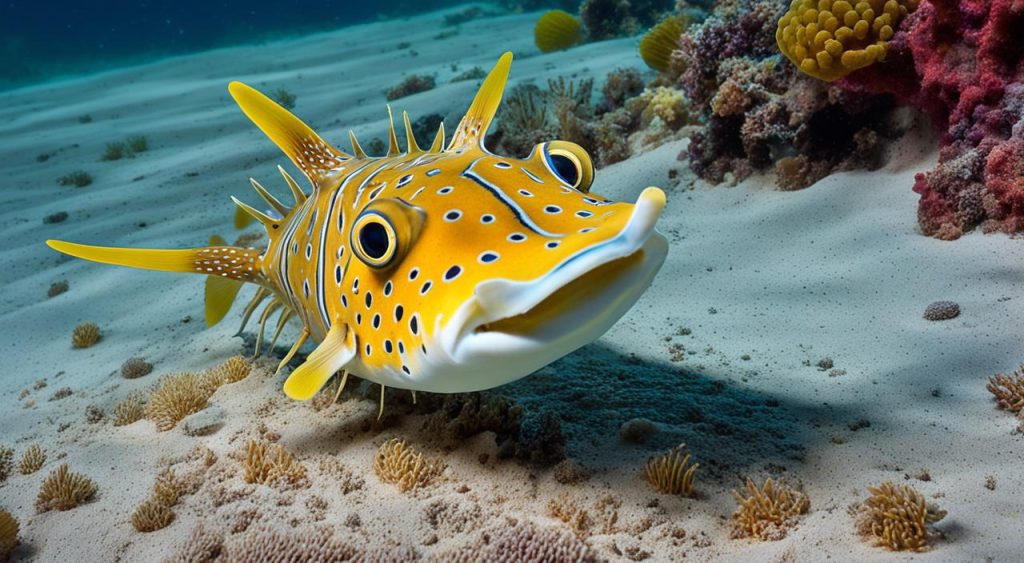
“The Longhorn Cowfish’s unique feeding strategy of blowing jets of water into the sandy substrate is a testament to its adaptability and resourcefulness in seeking out hidden prey.”
Unique Adaptations
The longhorn cowfish has many special features that make it stand out. It doesn’t have a gill cover, instead, it has a small slit or hole. This lets it breathe while keeping its box-like carapace.
Its body is covered in a hard, triangular carapace made of fused scales. This box-like structure protects it and lets it swim in an ostraciiform manner. It seems to hover in the water.
- Longhorn cowfish lack pelvic fins, instead relying on their long tail fin for propulsion.
- They are also capable of producing a variety of sounds, including hums and clicks, using specialized muscles connected to their swim bladder.
These special features, like the lack of a gill cover and its unique way of swimming, make the longhorn cowfish very interesting. It lives in tropical and subtropical waters.
| Adaptation | Description |
|---|---|
| Lack of Gill Cover | The longhorn cowfish lacks a traditional gill cover, instead having a small slit or hole for breathing. |
| Fused Hexagonal Scales | The body is covered in fused, hexagonal scales that form a solid, triangular, box-like carapace. |
| Ostraciiform Swimming | The unique body shape allows the longhorn cowfish to swim in an ostraciiform manner, appearing to hover in the water. |
| Lack of Pelvic Fins | Longhorn cowfish do not have pelvic fins, relying instead on their long tail fin for propulsion. |
| Sound Production | These fish can produce a variety of sounds, including hums and clicks, using muscles connected to their swim bladder. |
The longhorn cowfish’s special features, like its lack of a gill cover and its unique swimming and vocal abilities, make it a fascinating fish. It lives in tropical and subtropical waters.
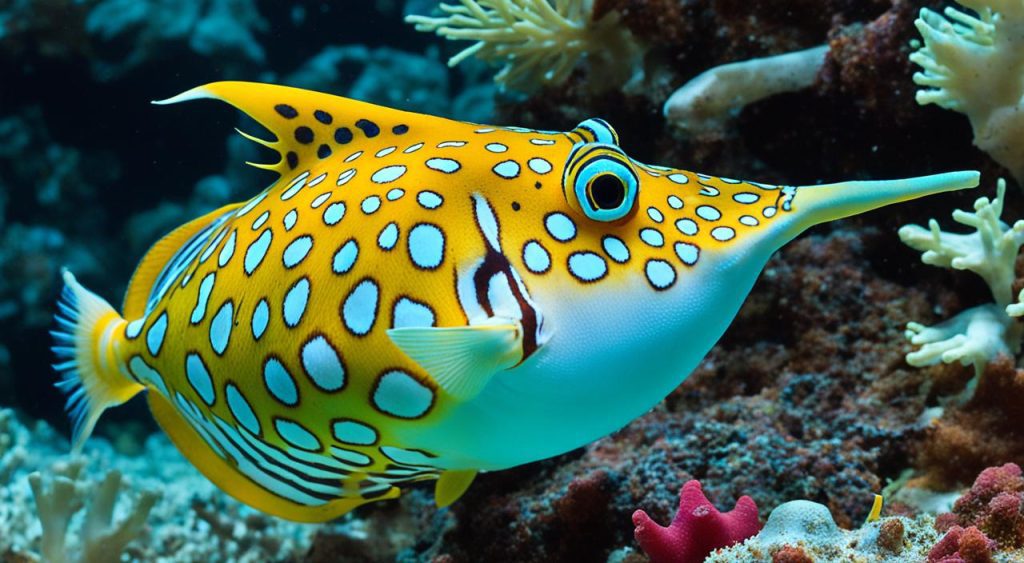
Longhorn Cowfish
The longhorn cowfish is a fascinating creature with a strong defense system. It has horns that are key to its survival. These horns help protect it from predators.
These horns are made of mineralized collagen fibers. They let the cowfish charge at threats and defend itself. If a horn gets damaged, it can grow back in a few months. This shows how resilient the cowfish is.
The cowfish also has a hard exoskeleton for extra protection. When it feels threatened, it can release a toxin called pahutoxin. This makes it even harder to attack.
This mix of physical and chemical defenses shows how well the longhorn cowfish has adapted. It helps it survive in tropical waters.
“The longhorn cowfish’s horns are truly remarkable, serving as both a defensive weapon and a means of regrowth. It’s a testament to the ingenuity of nature.”
The cowfish’s horns are vital for defending itself and keeping its unique look. They’re a great example of nature’s creativity. The cowfish’s special defenses help it thrive in tropical ecosystems.
Behavior and Social Structure
The longhorn cowfish are slow swimmers and make grunting noises when caught. They are usually alone and protect their own spots. But, they join in small groups of 3-4 females during breeding season.
Solitary and Territorial
Longhorn cowfish are slow swimmers and can be easily caught by hand. They often make grunting noises when captured, which is a way to defend themselves. These fish are solitary and territorial, marking and guarding their own areas.
They swim slowly, using their pectoral fins to move. This slow pace helps them blend in and use their toxin defense instead of speed to avoid predators.
“The Longhorn Cowfish can exude a deadly toxin called ostracitoxin if severely stressed.”
This defense and their territorial nature helps them live well in coral reefs and seagrass beds.
- Slow swimmers
- Easily caught by hand
- Make grunting noises when captured
- Solitary
- Territorial
But, they change their ways during breeding season. They form small harems with 3-4 females to boost their chances of mating and keeping their species going.
Reproduction and Life Cycle
Longhorn cowfish are fascinating creatures of tropical waters. They reproduce shortly after sunset or on cloudy days. Their breeding season is from February to October.
The female longhorn cowfish lays oval eggs during this time. These eggs hatch into juvenile larvae. What’s unique is that these larvae already have the box carapace armor of adult longhorn cowfish. This shows how well-adapted they are from the start.
The way they spawn and the armor on their larvae are key to their survival. These traits help them live well in tropical waters.
“The longhorn cowfish’s reproduction and life cycle are truly unique, with their oval eggs and armor-clad larvae showcasing the remarkable adaptations of this intriguing boxfish species.”
Conservation Status
The longhorn cowfish is a special fish in the boxfish family. It has the IUCN status of “Not Evaluated.” This means it’s not currently considered threatened. However, it could face issues from the aquarium trade and habitat damage, like coral reef destruction.
This fish is important for coral reef health. It eats animals that could harm the reefs. This helps keep the reefs healthy and strong.
Keeping coral reefs safe is key for the longhorn cowfish. We need to protect these areas from threats like aquarium trade and damage. This will help keep this unique fish in tropical waters.
| Key Statistic | Value |
|---|---|
| IUCN Status | Not Evaluated |
| Potential Threats | Aquarium trade, habitat degradation |
| Ecological Importance | Predator of invertebrates that can damage coral reefs |
We need more research and monitoring to protect the longhorn cowfish. This will help keep this special fish safe in its home.
Aquarium Keeping
Captive Care Challenges
Longhorn cowfish are sometimes kept in home tanks but need special care. They need a big tank with lots of hiding places and live rock to feel at home. They are very sensitive to changes in water quality, so the tank must be very clean.
These fish are not easy for beginners to take care of. They have special food needs and can release toxins. So, only advanced fish keepers should try to care for them.
A tank of at least 100 gallons is needed for one longhorn cowfish, and more space for several. Juveniles cost between $39.99 and $147, while adults can be over $200. With the right care, they can live 5 to 15 years in a tank.
Feeding them is a bit hard because they eat different foods like pellets, live foods, and veggies. The water must be kept just right, with a pH of 8.0-8.4 and hardness of 10-15 dGH. Good tank mates include dottybacks, angelfish, clownfish, and gobies.
“Longhorn cowfish are not for the faint of heart. They require specific conditions and can be challenging to care for, even for experienced aquarists.”
Ecological Significance
The longhorn cowfish are key players in tropical marine ecosystems. They help keep coral reefs healthy by eating invertebrates that could harm the reefs. Their actions also help coral reefs grow and thrive.
These fish show how diverse and rich tropical waters are. They are vital for the health and strength of coral reefs. Without them, these reefs might not be as vibrant or diverse.
We learn how important the longhorn cowfish are by seeing their role in nature. Protecting these fish and their homes is crucial for our planet’s health. They remind us of the need to keep our oceans diverse and strong.
FAQ
What is the longhorn cowfish?
The longhorn cowfish (Lactoria cornuta) is a unique boxfish from the family Ostraciidae. It’s known for its long, horn-like projections on its head.
What are the key features of the longhorn cowfish?
This fish has a yellow to olive base color with white or bluish spots. It’s famous for its long horns on its head. Its body is covered in hard, hexagonal scales, forming a box-like armor. It can grow up to 50 cm (20 in) long.
Where is the longhorn cowfish found?
It lives in coral reefs, mainly in tropical and subtropical waters. You can find it in the Red Sea, East Africa, Indonesia, and the Marquesas Islands. It also lives in southern Japan, including the Ryukyu Islands.
What does the longhorn cowfish eat?
It eats a mix of plants and animals. Its diet includes algae, microorganisms, foraminiferans, sponges, worms, mollusks, crustaceans, and small fish. It can also blow water to find food buried in the sand.
What are the unique adaptations of the longhorn cowfish?
It has no gill cover and its body is covered in hard, hexagonal scales. It can make sounds using its swim bladder muscles. Its shape lets it swim in a unique way, making it seem like it’s hovering.
How does the longhorn cowfish defend itself?
Its horns help it defend against predators. If a horn gets damaged, it can grow back in a few months. It also has a hard shell and can release a toxin when threatened.
What is the social behavior and reproduction of the longhorn cowfish?
They are slow-moving and usually live alone, defending their territory. In breeding season, they may form small groups. Females lay eggs that hatch into young with the same armor as adults.
What is the conservation status of the longhorn cowfish?
The longhorn cowfish is currently “Not Evaluated” by the IUCN. It’s not threatened now, but could be affected by the aquarium trade and habitat damage. It helps coral reefs by eating invertebrates that harm the reefs.
Can the longhorn cowfish be kept in home aquariums?
Some people keep them in aquariums, but they need special care. They need a big tank with lots of hiding spots and live rocks. They are sensitive to water quality and have special dietary needs. They’re best for experienced aquarists.




